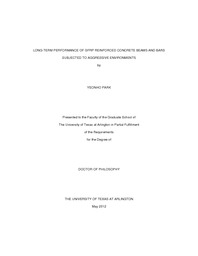
ATTENTION: The works hosted here are being migrated to a new repository that will consolidate resources, improve discoverability, and better show UTA's research impact on the global community. We will update authors as the migration progresses. Please see MavMatrix for more information.
Show simple item record
| dc.contributor.author | Park, Yeonho | en_US |
| dc.date.accessioned | 2012-07-25T19:09:14Z | |
| dc.date.available | 2012-07-25T19:09:14Z | |
| dc.date.issued | 2012-07-25 | |
| dc.date.submitted | January 2012 | en_US |
| dc.identifier.other | DISS-11626 | en_US |
| dc.identifier.uri | http://hdl.handle.net/10106/11079 | |
| dc.description.abstract | The use of fiber-reinforced polymer (FRP) bars in reinforced concrete (RC) structures has emerged as an alternative to traditional steel reinforcement environments and other applications where steel has shown greater vulnerability. Although the number of analytical and experimental studies on RC beams with FRP reinforcement has increased in recent decades, its long term performance is still questioned in comparison to the traditional steel reinforcement. That is, long-term performance is a much recognized but less-mentioned topic in the field of the reinforced concrete with glass-FRP (GFRP) re-bars. There is a need to validate long-term performance of FRP reinforced concrete structures, and accelerated testing can provide the data for this validation. In order to predict long-term behavior of reinforced concrete with GFRP bars (RC-GFRP), it is critical to determine the effects that long term exposure to the environment can have in degrading the composite materials. This study presents the results and discussion of an experimental study concerning long-term behaviors of GFRP bars and concrete beams reinforced with GFRP bars after accelerated aging for 300days in an environmental chamber at 115¢ªF(80% relative humidity). The change of strength/stiffness properties of GFRP bars and concrete beams reinforced with GFRP as compared to steel bars were investigated in this study for various conditioning schemes with the application of sustained loads. Two types (Wrapped surface / Sand-coated surface) of GFRP were used. All beams were clamped in pairs using transverse steel rods at the beam end to simulate cracks typical of those produced by in service conditions. Prior to exposure in the chamber, beams were pre-cracked to simulate the level of cracking seen during service loads. Tensile strength retentions of GFRP bars were tested and considered as the indicator of durability performance. Accelerated aging procedure was conservatively calibrated with the natural weathering data to obtain real time weathering based on the Arrhenius method. Analytical analysis was also conducted to investigate the degradation of strength/stiffness. In addition, not only the change of bond strength between GFRP bars and concrete after aging, but also the durability performance concrete beams with GFRP and steel bars were investigated after exposure to specific accelerated aging conditions(115¡ÆF ,RH=80% and 3% saline solution). A non-destructive acoustic emission technique was conducted to assess long-term performances of GFRP bars embedded in real concrete and concrete beams (reinforced with GFRP and steel bars) subjected to temperature, humidity and exposure to saline solution of aging conditions. Both the experimental testing and signal-processing procedures were reported in detail. Various parameters were extracted from the AE received signals and analyzed. In all cases, results showed not only that the strength and modulus of elasticity of GFRP and steel bars were reduced by the increase of exposure duration to cement-mortar paste at two different temperatures, but also the moment carrying capacities of RC-GFRP beams decreased and the deflections increased as a function of time when exposing in circumstances for accelerated aging. The effects of accelerated aging on the GFRP bars were not critical in terms of bond strength. The AE activity was found sensitive to duration of accelerated aging, type of reinforcement and reinforcement ratio. Acoustic emission technique could provide a useful verification of degradation level of concrete structures reinforced with GFRP and steel rods. | en_US |
| dc.description.sponsorship | Abolmaali, Ali | en_US |
| dc.language.iso | en | en_US |
| dc.publisher | Civil & Environmental Engineering | en_US |
| dc.title | Long-term Performance Of GFRP Reinforced Concrete Beams And Bars Subjected To Aggressive Environments | en_US |
| dc.type | Ph.D. | en_US |
| dc.contributor.committeeChair | Abolmaali, Ali | en_US |
| dc.degree.department | Civil & Environmental Engineering | en_US |
| dc.degree.discipline | Civil & Environmental Engineering | en_US |
| dc.degree.grantor | University of Texas at Arlington | en_US |
| dc.degree.level | doctoral | en_US |
| dc.degree.name | Ph.D. | en_US |
Files in this item
- Name:
- Park_uta_2502D_11626.pdf
- Size:
- 7.676Mb
- Format:
- PDF
This item appears in the following Collection(s)
Show simple item record


